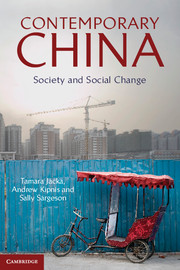Book contents
- Frontmatter
- Contents
- List of Images
- List of Maps
- List of Figures
- List of Tables
- Acknowledgments
- List of Abbreviations
- Map 0.1: China's provinces and provincial capitals
- Introduction
- Part 1 Social Institutions
- Part 2 Cultures, Socialization and the Formation of Identities
- 6 Religion, Ritual and Religiosity
- 7 Ethnicity
- 8 Education and the Cultivation of Citizens
- 9 Modernity, Youth Identities and Popular Culture
- Part 3 Inequalities, Injustices and Social Responses
- Glossary of Chinese Terms
- References
- Index
9 - Modernity, Youth Identities and Popular Culture
Published online by Cambridge University Press: 05 June 2014
- Frontmatter
- Contents
- List of Images
- List of Maps
- List of Figures
- List of Tables
- Acknowledgments
- List of Abbreviations
- Map 0.1: China's provinces and provincial capitals
- Introduction
- Part 1 Social Institutions
- Part 2 Cultures, Socialization and the Formation of Identities
- 6 Religion, Ritual and Religiosity
- 7 Ethnicity
- 8 Education and the Cultivation of Citizens
- 9 Modernity, Youth Identities and Popular Culture
- Part 3 Inequalities, Injustices and Social Responses
- Glossary of Chinese Terms
- References
- Index
Summary
How do young adults – people in their teens, twenties and thirties – build a sense of self and identity for themselves? And what impact does modernization have on young peoples' sense of identity, self-expression, values, and desires? These questions dominate the literature on youth in contemporary China, and form the framework for this chapter.
In the social sciences, as we noted in the introduction, modernization and modernity are commonly seen to entail urbanization, industrialization, the spread of mass education, commercialization, and advances in technology that enable the rapid flow of goods, values and people over increasing distances. Together, these are seen to lead to a breaking down of “traditional” social institutions, which previously socialized young people; clearly staked out how they were to move from childhood to adulthood; gave them stable identities; and fixed them in a rigid, hierarchical social order. As Marshall Berman, citing Marx and Engels, put it, “all that is solid melts into air”. With rapid change and cultural contact come uncertainties about our place in the world, and the future becomes less predictable. Possible identity schemes multiply, the formation of identities is less rigidly determined by existing local institutions such as the family and religious institutions and becomes more an individual project, and both the anxieties and freedoms associated with shaping an identity increase. Indeed, as the sociologist Anthony Giddens has seen it, self-identity becomes a question and a problem for the first time under modernity, and with “late modernity”, a person's life becomes more and more an individualized, reflexive project; a matter of actively choosing an identity, selecting a lifestyle, and identifying and planning life goals and how to actualize them.
- Type
- Chapter
- Information
- Contemporary ChinaSociety and Social Change, pp. 179 - 196Publisher: Cambridge University PressPrint publication year: 2013



